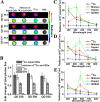Self-illuminating 64Cu-doped CdSe/ZnS nanocrystals for in vivo tumor imaging
- PMID: 24401138
- PMCID: PMC4004262
- DOI: 10.1021/ja410438n
Self-illuminating 64Cu-doped CdSe/ZnS nanocrystals for in vivo tumor imaging
Abstract
Construction of self-illuminating semiconducting nanocrystals, also called quantum dots (QDs), has attracted much attention recently due to their potential as highly sensitive optical probes for biological imaging applications. Here we prepared a self-illuminating QD system by doping positron-emitting radionuclide (64)Cu into CdSe/ZnS core/shell QDs via a cation-exchange reaction. The (64)Cu-doped CdSe/ZnS QDs exhibit efficient Cerenkov resonance energy transfer (CRET). The signal of (64)Cu can accurately reflect the biodistribution of the QDs during circulation with no dissociation of (64)Cu from the nanoparticles. We also explored this system for in vivo tumor imaging. This nanoprobe showed high tumor-targeting ability in a U87MG glioblastoma xenograft model (12.7% ID/g at 17 h time point) and feasibility for in vivo luminescence imaging of tumor in the absence of excitation light. The availability of these self-illuminating integrated QDs provides an accurate and convenient tool for in vivo tumor imaging and detection.
Figures



References
-
- Ntziachristos V.; Ripoll J.; Wang L. H. V.; Weissleder R. Nat. Biotechnol. 2005, 23, 313. - PubMed
-
- Wagnieres G. A.; Star W. M.; Wilson B. C. Photochem. Photobiol. 1998, 68, 603. - PubMed
-
- Luker G. D.; Luker K. E. J. Nucl. Med. 2008, 49, 1. - PubMed
-
- Sun Y.; Zhou B.; Lin Y.; Wang W.; Fernanodo K. A. S.; Pathak P.; Meziani M. J.; Harruff B. A.; Wang X.; Wang H.; Luo P. G.; Yang Hua; Kose M. E.; Chen B.; Veca L. M.; Xie S. J. Am. Chem. Soc. 2006, 128, 7756. - PubMed
-
- Baker S. N.; Baker G. A. Angew. Chem., Int. Ed. 2010, 49, 6726. - PubMed
Publication types
MeSH terms
Substances
Grants and funding
LinkOut - more resources
Full Text Sources
Other Literature Sources

